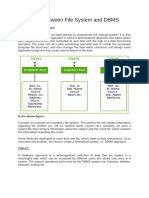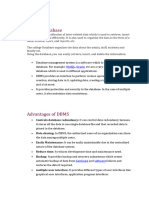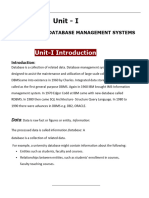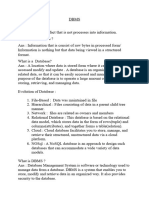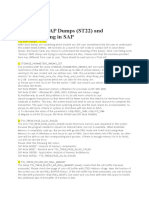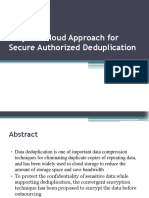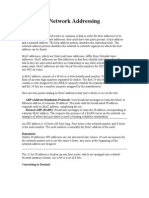File System Vs Database
File System Vs Database
Uploaded by
Zamal AhmedCopyright:
Available Formats
File System Vs Database
File System Vs Database
Uploaded by
Zamal AhmedOriginal Description:
Original Title
Copyright
Available Formats
Share this document
Did you find this document useful?
Is this content inappropriate?
Copyright:
Available Formats
File System Vs Database
File System Vs Database
Uploaded by
Zamal AhmedCopyright:
Available Formats
Difference between File System and
DBMS
The file system is basically a way of arranging the files in a storage medium like a hard
disk. The file system organizes the files and helps in the retrieval of files when they are
required. File systems consist of different files which are grouped into directories. The
directories further contain other folders and files. The file system performs basic
operations like management, file naming, giving access rules, etc.
Example: NTFS(New Technology File System), EXT(Extended File System).
File System
DBMS(Database Management System)
Database Management System is basically software that manages the collection of related
data. It is used for storing data and retrieving the data effectively when it is needed. It
also provides proper security measures for protecting the data from unauthorized access.
In Database Management System the data can be fetched by SQL queries and relational
algebra. It also provides mechanisms for data recovery and data backup.
Example:
Oracle, MySQL, MS SQL server.
DBMS
Difference between File System and DBMS
Basics File System DBMS
The file system is a way of
DBMS is software for managing
arranging the files in a storage
the database.
Structure medium within a computer.
Data Redundant data can be present in a In DBMS there is no redundant
Redundancy file system. data.
Basics File System DBMS
It doesn’t provide Inbuilt It provides in house tools for
Backup and mechanism for backup and recovery backup and recovery of data
Recovery of data if it is lost. even if it is lost.
Query There is no efficient query Efficient query processing is
processing processing in the file system. there in DBMS.
There is more data consistency
There is less data consistency in the
because of the process of
file system.
Consistency normalization.
It has more complexity in
It is less complex as compared to
handling as compared to the file
DBMS.
Complexity system.
DBMS has more security
File systems provide less security in
Security mechanisms as compared to file
comparison to DBMS.
Constraints systems.
It has a comparatively higher
It is less expensive than DBMS.
Cost cost than a file system.
In DBMS data independence
exists, mainly of two types:
There is no data independence.
Data 1) Logical Data Independence.
Independence 2)Physical Data Independence.
Only one user can access data at a Multiple users can access data at
User Access time. a time.
The users are not required to write The user has to write procedures
Meaning procedures. for managing databases
Data is distributed in many files. So, Due to centralized nature data
Sharing it is not easy to share data. sharing is easy
Basics File System DBMS
Data It give details of storage and It hides the internal details of
Abstraction representation of data Database
Integrity Integrity Constraints are difficult to Integrity constraints are easy to
Constraints implement implement
To access data in a file , user
requires attributes such as file name, No such attributes are required.
Attributes file location.
Example Cobol, C++ Oracle, SQL Server
The main difference between a file system and a DBMS (Database Management
System) is the way they organize and manage data.
1. File systems are used to manage files and directories, and provide basic operations for
creating, deleting, renaming, and accessing files. They typically store data in a
hierarchical structure, where files are organized in directories and subdirectories. File
systems are simple and efficient, but they lack the ability to manage complex data
relationships and ensure data consistency.
2. On the other hand, DBMS is a software system designed to manage large amounts of
structured data, and provide advanced operations for storing, retrieving, and
manipulating data. DBMS provides a centralized and organized way of storing data,
which can be accessed and modified by multiple users or applications. DBMS offers
advanced features like data validation, indexing, transactions, concurrency control,
and backup and recovery mechanisms. DBMS ensures data consistency, accuracy,
and integrity by enforcing data constraints, such as primary keys, foreign keys, and
data types.
In summary, file systems are suitable for managing small amounts of unstructured data,
while DBMS is designed for managing large amounts of structured data, and offers more
advanced features for ensuring data integrity, security, and performance.
You might also like
- Ingenico POS Terminal Download Instructions: Before Initiating A Download Expected Download TimeDocument1 pageIngenico POS Terminal Download Instructions: Before Initiating A Download Expected Download TimeDoNo ratings yet
- T24 Technical Architecture: Dateof Issue Version Changes byDocument7 pagesT24 Technical Architecture: Dateof Issue Version Changes byKLB USER100% (1)
- NetworkDocument3 pagesNetworkMarufNo ratings yet
- AssonebaseDocument5 pagesAssonebaseKayode Timilehin SamuelNo ratings yet
- (DBMS Concepts and Architecture) - 26-04-2023Document8 pages(DBMS Concepts and Architecture) - 26-04-2023Vaishnavi JagtapNo ratings yet
- Difference File and DbmsDocument2 pagesDifference File and Dbmstanu uppalNo ratings yet
- DBMS Unit 1Document19 pagesDBMS Unit 1traptikashyapjune13No ratings yet
- DBMS and ModelsDocument27 pagesDBMS and Modelsnainarawat05122000No ratings yet
- Bce Unit 5Document36 pagesBce Unit 5viveksendada2005tighraNo ratings yet
- DBMS-UNIT-1Document11 pagesDBMS-UNIT-1sgec.csehodNo ratings yet
- Dbms Unit 1 Minors-part-1Document95 pagesDbms Unit 1 Minors-part-1komaliNo ratings yet
- 12 CoddDocument5 pages12 CoddsaniyashaikhworksNo ratings yet
- DBMS Unit-1Document14 pagesDBMS Unit-1srisaikiranrelangiNo ratings yet
- Difference Between File System and DBMSDocument3 pagesDifference Between File System and DBMSnajskneekdkNo ratings yet
- Prashant RDBMS PresentationDocument11 pagesPrashant RDBMS Presentationprashant deolNo ratings yet
- Difference Between File System and DBMSDocument4 pagesDifference Between File System and DBMSveena shindeNo ratings yet
- DBMS Unit1 NotesDocument24 pagesDBMS Unit1 Notesteam 8No ratings yet
- Aligarh Muslim University: Submitted By: Ghazala FarooquiDocument17 pagesAligarh Muslim University: Submitted By: Ghazala FarooquiMd AMsh MahmoodNo ratings yet
- Introduction To DBMSDocument47 pagesIntroduction To DBMSChan DelierNo ratings yet
- File System and DBMS (ICT) - S4Document6 pagesFile System and DBMS (ICT) - S4masoomajafri11No ratings yet
- File Oriented System Vs DbmsDocument6 pagesFile Oriented System Vs DbmsHema AroraNo ratings yet
- DBMS (Unit 1)Document28 pagesDBMS (Unit 1)zakir hussainNo ratings yet
- Computer AssignmentDocument4 pagesComputer AssignmentFizza nawazNo ratings yet
- INT 306 Database Management SystemDocument24 pagesINT 306 Database Management SystemsushilNo ratings yet
- DBMS NotesDocument82 pagesDBMS Notesyashlanjewar370No ratings yet
- DBMSDocument18 pagesDBMSSrinivas RaoNo ratings yet
- KMBN It03 - Unit - 1Document18 pagesKMBN It03 - Unit - 1sumitrajput81720No ratings yet
- Unit 1part1Document20 pagesUnit 1part1AbhayNo ratings yet
- Unit One - DBMSDocument19 pagesUnit One - DBMSyashlanjewar370No ratings yet
- Database SystemDocument72 pagesDatabase SystemAbishek NeupaneNo ratings yet
- RDBMS Lesson NotesDocument192 pagesRDBMS Lesson NotesDeephaa PalaniappanNo ratings yet
- Dbms Unit 1 PptsDocument37 pagesDbms Unit 1 Pptsteam 8No ratings yet
- DBMS Unit1 NotesDocument25 pagesDBMS Unit1 NotesArjun SinghNo ratings yet
- What Is DatabaseDocument19 pagesWhat Is DatabaseNutan SannailaNo ratings yet
- Unit 1Document8 pagesUnit 1Anmol MogalaiNo ratings yet
- MOD1Document27 pagesMOD1Nidhi SrivastavaNo ratings yet
- Difference Between File System and DbmsDocument1 pageDifference Between File System and DbmsPPPNo ratings yet
- UT-1 DBMS ShenbagamDocument27 pagesUT-1 DBMS Shenbagamfortune gamerNo ratings yet
- File SystemDocument2 pagesFile SystemBikram ShresthaNo ratings yet
- Database ApproachDocument12 pagesDatabase ApproachHaseeb KhalidNo ratings yet
- Presentation On DBMS Versus File SystemDocument7 pagesPresentation On DBMS Versus File Systemdas9434945589No ratings yet
- Unit 1Document35 pagesUnit 1Dead ManNo ratings yet
- DBMSDocument95 pagesDBMSLAXMAN MEENANo ratings yet
- Dbms Mod1fullshirinDocument23 pagesDbms Mod1fullshirinfoxmicky323No ratings yet
- Lesson01 IntroductionDocument5 pagesLesson01 Introductionmwangibrian1293No ratings yet
- DBMSDocument16 pagesDBMSkuabhi986No ratings yet
- Unit - 1Document35 pagesUnit - 1firdaushjahan17No ratings yet
- BasisDocument19 pagesBasissunny singhNo ratings yet
- DBMS U-1 Combined NotesDocument152 pagesDBMS U-1 Combined NotesgabberhramiNo ratings yet
- DBMS Vs Files System.6Document1 pageDBMS Vs Files System.6SHIWANI PAL CS-18No ratings yet
- 2 File System Vs Database SystemDocument1 page2 File System Vs Database SystemMukesh KumarNo ratings yet
- A211 - MTD3033 Assignment 1 Concept (Group)Document11 pagesA211 - MTD3033 Assignment 1 Concept (Group)MUHAMMAD ASSRAF BIN ABDULLAHNo ratings yet
- DBMS-Question and Answer Bank - SOCET-CE-Department - 211127 - 223259Document81 pagesDBMS-Question and Answer Bank - SOCET-CE-Department - 211127 - 223259Dhruv ShahNo ratings yet
- Dbms ConceptDocument36 pagesDbms Conceptvu4f2223087No ratings yet
- Giyaz Ppts DbmsDocument59 pagesGiyaz Ppts DbmsnallagattuchittiNo ratings yet
- Dbms and Data WarehouseDocument32 pagesDbms and Data WarehouseSuman ChatterjeeNo ratings yet
- notes dbms1Document30 pagesnotes dbms1alyaansiddiqui998No ratings yet
- KMBNIT03 - Unit 1Document24 pagesKMBNIT03 - Unit 1Aditya PandeyNo ratings yet
- DBMSDocument56 pagesDBMSABDULLAH AlviNo ratings yet
- Overview of File SystemsDocument13 pagesOverview of File SystemsRitik SainiNo ratings yet
- DBMSDocument19 pagesDBMSGadgetNo ratings yet
- HLR-FE Object Description FileDocument2 pagesHLR-FE Object Description FileJames ForwardNo ratings yet
- SPNGN2101SG Vol1 PDFDocument352 pagesSPNGN2101SG Vol1 PDFDwi Utomo100% (3)
- Microcontroller Lab ManualDocument38 pagesMicrocontroller Lab Manualharshitha100% (1)
- Subnet GuideDocument4 pagesSubnet Guidetahazzad hossainNo ratings yet
- AUTODYN - Chapter 11 - Parallel - Processing PDFDocument42 pagesAUTODYN - Chapter 11 - Parallel - Processing PDFFabiano OliveiraNo ratings yet
- Ipvanish VPNDocument3 pagesIpvanish VPNPappu Khan50% (2)
- How To Build Your Own Mikrotik WifiDocument14 pagesHow To Build Your Own Mikrotik WifiHafidz Jazuli LuthfiNo ratings yet
- Top 20+ Windows Server Interview Questions 2022Document310 pagesTop 20+ Windows Server Interview Questions 2022Depolo PoloNo ratings yet
- AE LeapCamp VEGA AIR Introduction Alice 20220414Document25 pagesAE LeapCamp VEGA AIR Introduction Alice 20220414khaledhassangamal9516No ratings yet
- FTP EmailDocument3 pagesFTP Emailtamanna13No ratings yet
- Common ABAP Dumps (ST22) and Troubleshooting in SAPDocument13 pagesCommon ABAP Dumps (ST22) and Troubleshooting in SAPatu1981No ratings yet
- Training Break Up - SAP BTP - Basics To AdvancedDocument3 pagesTraining Break Up - SAP BTP - Basics To AdvancedCleoNo ratings yet
- LogDocument18 pagesLogRamdoni PratamaNo ratings yet
- PXW x70 FTP Transfer Guide 0316Document27 pagesPXW x70 FTP Transfer Guide 0316Ítalo Jiménez YarlequéNo ratings yet
- How To Reset Root Password in LinuxDocument7 pagesHow To Reset Root Password in LinuxSopan sonarNo ratings yet
- CLI CommandsDocument4 pagesCLI CommandsRui GomesNo ratings yet
- A Hybrid Cloud Approach For Secure Authorized DeduplicationDocument15 pagesA Hybrid Cloud Approach For Secure Authorized DeduplicationDaniel BlissonNo ratings yet
- 4.shared Authority Based PrivacyDocument4 pages4.shared Authority Based Privacykhushboo_khannaNo ratings yet
- HPE StoreEasy 1660 Expanded Storage With Microsoft Windows Server IoT 2019-PSN1013310645CZENDocument5 pagesHPE StoreEasy 1660 Expanded Storage With Microsoft Windows Server IoT 2019-PSN1013310645CZENlefebi6403No ratings yet
- Gelscan English ShortDocument1 pageGelscan English ShortRichard PonceNo ratings yet
- 6.0 Introduction To Real-Time Operating Systems (Rtos)Document35 pages6.0 Introduction To Real-Time Operating Systems (Rtos)dhananjaypatilmeNo ratings yet
- VPlayer User GuideDocument3 pagesVPlayer User GuideIsaac NewtonNo ratings yet
- Network AddressingDocument4 pagesNetwork Addressingapi-3840010No ratings yet
- Microsoft Exchange 2003-2007 Admin Interview QADocument140 pagesMicrosoft Exchange 2003-2007 Admin Interview QAajitskhot108No ratings yet
- Blue Screen ErrorDocument5 pagesBlue Screen ErrorIim abdurohimNo ratings yet
- Nachos Overview Project 1 - Thread Management: Chien Wen, Huang. Advisor: Farn, WangDocument26 pagesNachos Overview Project 1 - Thread Management: Chien Wen, Huang. Advisor: Farn, WangAnanya KallankudluNo ratings yet
- Lab RISC-VDocument5 pagesLab RISC-VJuan Diego JavierNo ratings yet
- Wabbit InstructionsDocument5 pagesWabbit InstructionsEthanDavesNo ratings yet















